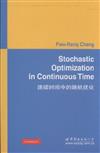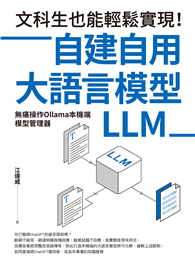對數學方法的討論更加直觀,並且用大量的經濟例子來說明,更重要的是數學概念的引入在語言和術語上是經濟專業的研究生所熟悉的。盡管許多論題在數學、經濟和金融書中都是比較普遍的,但仍然用大量的經濟學實例加以解釋。
書中強調了隨機微積分的重點和非重點,需要提醒讀者的是許多經濟學家所想要的特定結果和觀點並沒有擴展至隨機模型中。隨機控制問題是確定優化策略函數必須的,第五章致力於用各種途徑尋找隨它的值函數的封閉形式表示。書中有大量的練習,每章末包含注解和建議閱讀文獻。
| FindBook |
有 1 項符合
連續時間中的隨機優化(英文)的圖書 |
 |
連續時間中的隨機優化-(影印版) 出版社:世界圖書出版公司 出版日期:2013-01-01 語言:簡體書 |
| 圖書選購 |
| 型式 | 價格 | 供應商 | 所屬目錄 | $ 238 |
首頁 |
|---|
| 圖書館借閱 |
| 國家圖書館 | 全國圖書書目資訊網 | 國立公共資訊圖書館 | 電子書服務平台 | MetaCat 跨館整合查詢 |
| 臺北市立圖書館 | 新北市立圖書館 | 基隆市公共圖書館 | 桃園市立圖書館 | 新竹縣公共圖書館 |
| 苗栗縣立圖書館 | 臺中市立圖書館 | 彰化縣公共圖書館 | 南投縣文化局 | 雲林縣公共圖書館 |
| 嘉義縣圖書館 | 臺南市立圖書館 | 高雄市立圖書館 | 屏東縣公共圖書館 | 宜蘭縣公共圖書館 |
| 花蓮縣文化局 | 臺東縣文化處 |
|
|
圖書介紹 - 資料來源:博客來 評分:
圖書名稱:連續時間中的隨機優化(英文)
內容簡介
目錄
List of Figures
Preface
1 Probability Theory
1.1 Introduction
1.2 Stochastic Processes
1.2.1 In formation Sets and a -Algebras
1.2.2 The Cantor Set
1.2.3 Borel-Cantelli Lemmas
1.2.4 Distribution Functions and Stochastic Processes
1.3 Conditional Expectation
1.3.1 Conditional Probability
1.3.2 Conditional Expectation
1.3,3 Change of Variables
1.4 Notes and Further Readings
2 Wiener Processes
2.1 introduction
2.2 A Heuristic Approach
2.2.1 From Random Walks to Wiener Process
2.2.2 Some Basic Properties of the Wiener Process
2.3 Markov Processes
2.3.1 Introduction
2.3.2 Transition Probability
2.3.3 Diffusion Processes
2.4 Wiener Processes
2.4.1 How to Generate More Wiener Processes
2.4.2 Differentiability of Sample Functions
2.4.3 Stopping Times
2.4.4 The Zero Set
2.4.5 Bounded Variations and the Irregularity of the
Wiener Process
2.5 Notes and Further Readings
3 Stochastic Calculus
3.1 Introduction
3.2 A Heuristic Approach
3.2.1 ls □ (s X )dWs Riemarm Integrable?
3.2.2 The Choice of□ Matters
3.2.3 In Search of the Class of Functions for a (s, w)
3.3 The Ito Integral
3.3.1 Definition
3.3.2 Martingales
3.4 lto’’s Lemma: Autonomous Case
3.4.1 Ito’’s Lemma
3.4.2 Geometric Brownian Motion
3.4.3 Population Dynamics
3.4.4 Additive Shocks or Multiplicative Shocks
3.4.5 Multiple Sources of Uncertainty
3.4.6 Multivariate lto’’s Lemma
3.5 Ito’’s Lemma for Time-Dependent Functions
3.5.1 Euler’’s Homogeneous Differential Equation and the Heat Equation
3.5.2 Black-Scholes Formula
3.5.3 Irreversible Investment
3.5.4 Budget Equation for an Investor
3.5.5 Ito’’s Lemma: General Form
3.6 Notes and Further Readings
4 Stochastic Dynamic Programming
4.1 Introduction
4.2 Bellman Equation
4.2.1 Infinite-Horizon Problems
4.2.2 Verification Theorem
4.2.3 Finite-Horizon Problems
4.2.4 Existence and Differentiability of the Value Function
4.3 Economic Applications
4.3.1 Consumption and Portfolio Rules
4.3.2 Index Bonds
4.3.3 Exhaustible Resources
4.3.4 Adjustment Costs and (Reversible) Investment
4.3.5 Uncertain Lifetimes and Life Insurance
4.4 Extension: Reeursive Utility
4.4.1 Bellman Equation with Recursive Utility
4.4.2 Effects of Reeursivity: Deterministic Case
4.5 Notes and Further Readings
5 How to Solve it
5.1 Introduction
5.2 HARA Functions
5.2.1 The Meaning of Each Parameter
5.2.2 Closed-Form Representations
5.3 Trial and Error
5.3.1 Linear-Quadratic Models
5.3.2 Linear-HARA models
5.3.3 Linear-Concave Models
5.3,4 Nonlinear-Concave Models
5.4 Symmetry
5.4.1 Linear-Quadratic Model Revisited
5.4.2 Merton’’s Model Revisited
5.4.3 Fischer’’s Index Bond Model
5.4.4 Life Insurance
5.5 The Substitution Method
5.6 Martingale Representation Method
5.6.1 Girsanov Transformation
5.6.2 Example: A Portfolio Problem
5.6.3 Which 8 to Choose?
5.6.4 A Transformed Problem
5.7 Inverse Optimum Method
5.7.1 The Inverse Optimal Problem: Certainty Case
5.7.2 The Inverse Optimal Problem: Stochastic Case
5.7.3 Inverse Optimal Problem of Merton’’s Model
5.8 Notes and Further Readings
6 Boundaries and Absorbing Barriers
6.1 Introduction
6.2 Nonnegativity Constraint
6.2.1 Issues and Problems
6.2.2 Comparison Theorems
6.2.3 Chang and Malliaris’’s Reflection Method
6.2.4 Inaccessible Boundaries
6.3 Other Constraints
6.3.1 A Portfolio Problem with Borrowing CoosWaints
6.3.2 Viscosity Solutions
6.4 Stopping Rules - Certainty Case
6.4.1 The Baumol-Tobin Model
6.4.2 A Dynamic Model of Money Demand
6.4.3 The Tree-Cutting Problem
6.5 The Expected Discount Factor
6.5.1 Fundamental Equation for Ex[e□]
6.5.2 One Absorbing Barrier
6.5.3 Two Absorbing Barriers
6.6 Optimal Stopping Times
6.6.1 Dynamic and Stochastic Demand for Money
6.6.2 Stochastic Tree-Cutting and Rotation Problems
6.6.3 Investment Timing
6.7 Notes and Further Readings
A Miscellaneous Applications and Exercises
Bibliography
Index
Preface
1 Probability Theory
1.1 Introduction
1.2 Stochastic Processes
1.2.1 In formation Sets and a -Algebras
1.2.2 The Cantor Set
1.2.3 Borel-Cantelli Lemmas
1.2.4 Distribution Functions and Stochastic Processes
1.3 Conditional Expectation
1.3.1 Conditional Probability
1.3.2 Conditional Expectation
1.3,3 Change of Variables
1.4 Notes and Further Readings
2 Wiener Processes
2.1 introduction
2.2 A Heuristic Approach
2.2.1 From Random Walks to Wiener Process
2.2.2 Some Basic Properties of the Wiener Process
2.3 Markov Processes
2.3.1 Introduction
2.3.2 Transition Probability
2.3.3 Diffusion Processes
2.4 Wiener Processes
2.4.1 How to Generate More Wiener Processes
2.4.2 Differentiability of Sample Functions
2.4.3 Stopping Times
2.4.4 The Zero Set
2.4.5 Bounded Variations and the Irregularity of the
Wiener Process
2.5 Notes and Further Readings
3 Stochastic Calculus
3.1 Introduction
3.2 A Heuristic Approach
3.2.1 ls □ (s X )dWs Riemarm Integrable?
3.2.2 The Choice of□ Matters
3.2.3 In Search of the Class of Functions for a (s, w)
3.3 The Ito Integral
3.3.1 Definition
3.3.2 Martingales
3.4 lto’’s Lemma: Autonomous Case
3.4.1 Ito’’s Lemma
3.4.2 Geometric Brownian Motion
3.4.3 Population Dynamics
3.4.4 Additive Shocks or Multiplicative Shocks
3.4.5 Multiple Sources of Uncertainty
3.4.6 Multivariate lto’’s Lemma
3.5 Ito’’s Lemma for Time-Dependent Functions
3.5.1 Euler’’s Homogeneous Differential Equation and the Heat Equation
3.5.2 Black-Scholes Formula
3.5.3 Irreversible Investment
3.5.4 Budget Equation for an Investor
3.5.5 Ito’’s Lemma: General Form
3.6 Notes and Further Readings
4 Stochastic Dynamic Programming
4.1 Introduction
4.2 Bellman Equation
4.2.1 Infinite-Horizon Problems
4.2.2 Verification Theorem
4.2.3 Finite-Horizon Problems
4.2.4 Existence and Differentiability of the Value Function
4.3 Economic Applications
4.3.1 Consumption and Portfolio Rules
4.3.2 Index Bonds
4.3.3 Exhaustible Resources
4.3.4 Adjustment Costs and (Reversible) Investment
4.3.5 Uncertain Lifetimes and Life Insurance
4.4 Extension: Reeursive Utility
4.4.1 Bellman Equation with Recursive Utility
4.4.2 Effects of Reeursivity: Deterministic Case
4.5 Notes and Further Readings
5 How to Solve it
5.1 Introduction
5.2 HARA Functions
5.2.1 The Meaning of Each Parameter
5.2.2 Closed-Form Representations
5.3 Trial and Error
5.3.1 Linear-Quadratic Models
5.3.2 Linear-HARA models
5.3.3 Linear-Concave Models
5.3,4 Nonlinear-Concave Models
5.4 Symmetry
5.4.1 Linear-Quadratic Model Revisited
5.4.2 Merton’’s Model Revisited
5.4.3 Fischer’’s Index Bond Model
5.4.4 Life Insurance
5.5 The Substitution Method
5.6 Martingale Representation Method
5.6.1 Girsanov Transformation
5.6.2 Example: A Portfolio Problem
5.6.3 Which 8 to Choose?
5.6.4 A Transformed Problem
5.7 Inverse Optimum Method
5.7.1 The Inverse Optimal Problem: Certainty Case
5.7.2 The Inverse Optimal Problem: Stochastic Case
5.7.3 Inverse Optimal Problem of Merton’’s Model
5.8 Notes and Further Readings
6 Boundaries and Absorbing Barriers
6.1 Introduction
6.2 Nonnegativity Constraint
6.2.1 Issues and Problems
6.2.2 Comparison Theorems
6.2.3 Chang and Malliaris’’s Reflection Method
6.2.4 Inaccessible Boundaries
6.3 Other Constraints
6.3.1 A Portfolio Problem with Borrowing CoosWaints
6.3.2 Viscosity Solutions
6.4 Stopping Rules - Certainty Case
6.4.1 The Baumol-Tobin Model
6.4.2 A Dynamic Model of Money Demand
6.4.3 The Tree-Cutting Problem
6.5 The Expected Discount Factor
6.5.1 Fundamental Equation for Ex[e□]
6.5.2 One Absorbing Barrier
6.5.3 Two Absorbing Barriers
6.6 Optimal Stopping Times
6.6.1 Dynamic and Stochastic Demand for Money
6.6.2 Stochastic Tree-Cutting and Rotation Problems
6.6.3 Investment Timing
6.7 Notes and Further Readings
A Miscellaneous Applications and Exercises
Bibliography
Index
|









